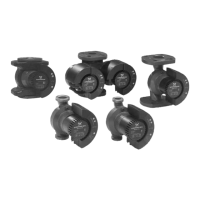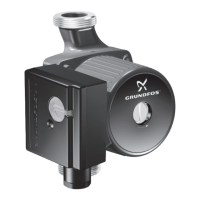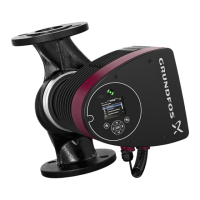English (GB)
8
Three-phase motors of 3 kW and up
These motors have built-in thermistors (PTC)*. The
thermistors are designed according to DIN 44082.
The motor protection is of the TP 211 type which
reacts to both slow- and quick-rising temperatures.
* Applies only to motors for the following supply
voltages:
• 3 x 200 V / 346 V, 50 Hz
• 3 x 200-220 V / 346-380 V, 60 Hz
• 3 x 220-240 V / 380-415 V, 50 Hz.
Motors for other supply voltages must be connected
to a motor-protective circuit breaker as described for
three-phase motors up to 3 kW.
7.3 Electrical connection
Carry out the electrical connection as shown in the
diagram inside the terminal box cover.
Fig. 9 Wiring diagram
7.4 Frequency converter operation
You can connect three-phase motors to a frequency
converter.
Depending on the frequency converter type, this may
cause increased acoustic noise from the motor.
Furthermore, it may cause the motor to be exposed
to detrimental voltage peaks.
* MG 71- and MG 80-based motors with phase
insulation are available on request.
The above disturbances, i.e. both increased acoustic
noise and detrimental voltage peaks, can be
eliminated by fitting an LC filter between the
frequency converter and the motor.
For further information, please contact the frequency
converter supplier or Grundfos.
8. Startup
8.1 Non-self-priming pumps
8.1.1 Liquid filling
1. Close the isolating valve on the discharge side of
the pump.
2. Open the isolating valve in the suction pipe
completely before starting the pump.
3. Remove the filling plug. See fig. 10.
4. Fill the pump housing and the suction pipe
completely with liquid until a steady stream of
liquid runs out of the filling hole.
5. Fit and tighten the filling plug.
6. Start the pump and slowly open the discharge
isolating valve while the pump is running. This
ensures venting and pressure build-up during
startup.
Fig. 10 Position of filling hole and drain hole
8.2 Self-priming pumps
TM03 8781 1008
MG 71- and MG 80-based motors have no
phase insulation* and must therefore be
protected against voltage peaks higher
than 650 V (peak value) between the
supply terminals.
Self-priming pumps only:
If the pump is connected to a frequency
converter, operation at low speed may
cause the internal recirculation valve to
open. This will result in a drop in pressure
and flow.
If there is a risk of condensation in the
motor, remove the motor drain plug before
startup and keep the drain hole open
during operation. See fig. 7.
Do not start the pump until it has been
filled with liquid.
Warning
Pay attention to the direction of the vent
hole, and make sure that the escaping hot
or cold liquid does not cause injury to
persons or damage to the equipment.
The discharge isolating valve must be
opened immediately after startup of the
pump. Otherwise the temperature of the
pumped liquid may become too high and
cause damage to the equipment.
TM03 8774 1008
If it is difficult for the pump to build up
pressure, it may be necessary to repeat
steps 1 to 6.
Do not start the pump until it has been
filled with liquid.

